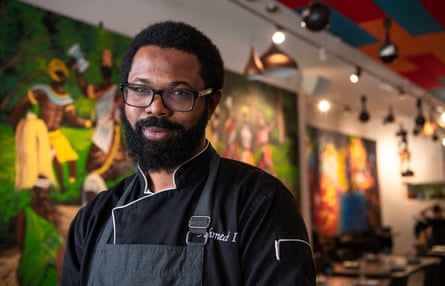Finding fufu: Australia’s growing appetite for West African food
In Australian cities, Ethiopian and Sudanese restaurants have introduced diners to injera, that fermented flatbread wonder; while home cooks’ growing familiarity with Moroccan and Egyptian cuisine means ras el hanout has its place in our globalised pantries. These food habits reflect the waves of migration over the decades – historically, Australians with African ancestry are mostly from South Africa, Zimbabwe, Egypt, Somalia, Sudan and South Sudan.
But if new Ghanaian, Nigerian and Cameroonian food businesses are a barometer for demographic change, the West African community and diaspora is growing, and customers are actively seeking out its cuisine and ingredients. This is also supported by the latest census data – in five years, the number of people in Australia who were born in Nigeria increased by about 50%, from 8,493 people in 2016 to 12,883 in 2021.

The main ingredients in West African food are rice, cassava, plantain and cocoyam (taro), Ghanaian chef-owner of Melbourne’s Akwaaba restaurant, Ahmed Inusah, says. But each country or even household might cook it differently. “I would say West African food is carb- and meat-based and it has earthy flavours. Palm oil is also important. We cook a lot with it,” he says. Unrefined palm oil has a rich, earthy, slightly nutty taste and gives dishes a red-gold tinge.
The Cameroonian owner and chef of Vola Foods in Melbourne, Ashley Vola, expands on the hyper-regionalisation of West African food, which is influenced by colonisation, trade and terrain. “In Cameroon, there’s the English part and the French part. Every province will also have its signature dish. From my mum’s side, the dish is achu which is made with taro and a bit of mashed banana. From my dad’s side, it’s fufu and njama njama, which is a spinach-like vegetable.”

If fufu – a mashed, dough-like starch dish – sounds familiar, it could be because of its popularity on social media. It is traditionally made with any starch such as yam, plantain, cassava or taro – sometimes a combination of starches. Recipes vary, but the produce might be boiled, pounded in a mortar and pestle until it reaches a fluffy, dough-like consistency, then rolled into a ball and eaten with soups or stews.

Today, there are easy-serve packs of dehydrated fufu for those with limited time, plantains or access to a mortar and pestle. Owner of African Pride Superstore and Restaurant in Adelaide, Aime Ruigira, can vouch for the growing popularity of the staple dish. “I started this business 14 years ago and today my bestseller is fufu,” he says. “Customers tell me they saw it on YouTube and want to try it. I think it is quite popular because it is gluten-free and nut-free so it is suitable for people with food allergies.”
Another dish best associated with West Africa is jollof, a one-pot tomato rice dish that is cooked in layers and varies significantly between countries, regions and households. It is also the cause of diplomatic incidents, outrage towards Jamie Oliver’s version and good-natured ribbing among West Africans who all claim their version is the best. Vola describes her version as a tomato stew that is thicker than passata; it could also be described as a vegan paella. In other versions, the rice dish might be cooked in meat-based stock.

The rice dish is the headline act at Naija Jollof, a Nigerian restaurant in Sydney’s inner west by Oluwaloseyi Tajudeen Olateju and Hawanatu Wanda Koroma. “Everyone has their own version of jollof but the main ingredients are tomato, onions, capsicum and rice. The seasoning is up to you,” Koroma says. This may include a range of herbs and spices including thyme, rosemary, ginger and chilli powder.
The key to good jollof is its distinctive smoky flavour, which can be achieved by cooking over firewood or dehydrating the tomatoes before making the stew. Koroma has a simpler option for beginners: char the capsicum first. “And always use red capsicum, never green,” she stresses.

Fufu and jollof have crept into our collective culinary lexicon, but Vola has introduced a lesser-known dish from her homeland: borning fish. “It is a whole fish, marinated with spices like njansang [a nutty seed from a tree of the same name] and a type of Cameroonian nutmeg before grilling on a charcoal barbecue. Australians typically do not like bones in their fish, but I couldn’t bear to change it! We’re really lucky that we’re in a part of Melbourne where people respond really well to new food.”
Although Australia’s West African community and restaurant scene is growing, chefs are still having to compromise with local produce. “We have a stew called kontomire made with taro leaves, which is not easy to get,” says Inusah, who substitutes silverbeet or spinach instead.

Because of this, Vola is hopeful local growers will spy a gap in the market. “Parts of Queensland could be suitable to grow yam, plantains, okra. Maybe bitter leaf for soup.” It’s an intriguing challenge, and a sign of what could be in our shopping baskets in the years to come.



